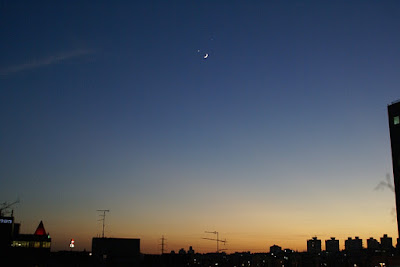Update! For photos of the 2012-03-13 Conjunction go to
Venus and Jupiter conjunction part 2
This month it will be very easy to watch the celestial movements of the
planets. Venus is moving toward Jupiter and away from it. Today
(4-Mar-2012), Venus is still below Jupiter but this is going to change,
and change quickly in the coming days. Just look west every day after
sunset and you will see how the distance between Venus and Jupiter
decreases. Most of the movement is of Venus which is an interior planet
(Its path is between the Earth and the Sun) and seems to move quite
fast. Jupiter is further away and slow, and moves maybe five minutes of an
angle per day so for this purpose you can treat it as a star which is
fixed in its position.
On 13-Mar-2012 Venus and Jupiter will be very close to each other, just 3
degrees apart. When two celestial orbs are so close to each other it is
called a conjunction. Such conjunctions of two planets are not rare
(but pairs of rare planets such as Neptune, Uranus and Saturn are).
Jupiter and Venus are the brightest planets, and way back in the past,
on June 17th, 2 BC, their conjunction made them so close together, just
40 arc-seconds apart that they seemed as a single, very bright star,
which might be the origin of the "Star of Bethlehem" (although there are
other astronomical theories for this star, such as a Supernova, a comet
or other conjunctions). Look at the Illustration below. An observer
would see this incredible sight through his telescope at 100x
magnification. Venus is closer to Jupiter than Jupiter's moons, and is
just a little bit smaller than Jupiter. Jupiter angular size is 32" and
Venus only 25". This is indeed a sight not often seen! An even better
conjunction will be at 22-Nov-2065, when Venus will actually go in front
of Jupiter, obscuring a little part of it. Unfortunately Jupiter and
Venus will be only 7 degrees from the Sun so the chances to see it is
very small
 |
| Illustration of Jupiter and Venus conjunction from year 2BC |
In this conjunction, Venus and Jupiter will not be that close and will
appear somewhat like the 2008 conjunction below, but still, it is a nice
view to watch.
 |
| The new moon, Venus and Jupiter (2008) |
 |
| Moon, Venus and Jupiter conjunction (2008) |
![Moon, Venus and Jupiter conjunction]() |
| Moon, Venus and Jupiter conjunction (2008) |
What will happen after the conjunction? Venus will continue to go higher until its western elongation, the point where it is furthest away from the Sun. This will happen at the end of March and after that Venus will start to go back down toward the Sun (getting closer to Earth). Viewing Venus with a telescope will show that it is waning, becoming more and more into a thin crescent, but at the same time, as it is getting closer to Earth, the apparent size of Venus grows. This is way Venus magnitude will not change much during that time. However, as Venus gets closer to the Sun, it will be very hard to see it. The final day of Venus being an evening start will be of course at June 6 (or 5) in the coming Venus Transit. Venus will go over the face of the sun and become a morning star (As will also Jupiter which will go to the "other side" of the sun at mid May)


